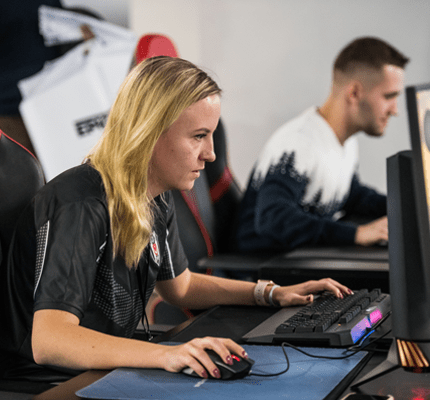
Are Esports Striving for Gender Diversity?
Video games aren’t just for play anymore. Esports are becoming more common as recruitment tools for students, particularly students in science, technology, engineering, and math (STEM) fields. Some universities offer special esports facilities, coaching staffs, and scholarships. In addition, many universities host esports clubs, which offer students informal opportunities to connect with one another. Although varsity esports are growing in North America, they are still relatively new and are not affiliated with the National College Athletics Association (NCAA), which governs other intercollegiate sports. In a new article published in Critical Studies in Media Communication, Nicholas Taylor and Bryce Stout interview leaders about gender diversity in North American esports clubs and varsity programs.
Gender and Esports
The world of professional esports is dominated by men; many of the most-popular games, such as Counterstrike: GO and League of Legends, also have a masculine culture associated with them. In addition, gaming culture has been associated historically with technical and computational abilities, which are inaccurately stereotyped as masculine skills. However, women are increasingly involved in professional esports as players, broadcasters, team managers, and in other roles. Unfortunately, some women professional players also face harassment, which may discourage other women from pursuing careers in esports.
Taylor and Stout argue that, in contrast to the professional scene, casual university esports clubs may offer the possibility for greater gender diversity due to the different skill levels and the different levels of commitment to gaming within clubs. In addition, universities often have policies that attempt to foster inclusivity on campus. In the study, Taylor and Stout also investigate whether the inclusivity commitments of North American universities are reflected in varsity and esport clubs.
The Study
Taylor and Stout conducted 21 telephone or Skype interviews with “collegiate esports leaders from post-secondary institutions across the United States and Canada.” The majority of the participants (13) were undergraduate students, while three were faculty and six were salaried non-faculty (including one of the undergraduates). This roughly matches the number of participants that led casual esports clubs (13) and varsity esports programs (eight). All of the esports coaches in the study were men, and all but one were white. Many had professional and semi-professional careers playing esports prior to becoming coaches. Study participants answered questions about the nature of the esports organizations on their campuses, as well as answering questions about what “diversity” means to them.
Results
Varsity Esports
Many varsity esports programs in the study are housed at small, information technology (IT) or STEM-focused U.S. colleges. These programs usually have between 22 and 50 players who play League of Legends, Overwatch, or other games that are played professionally. Because of the STEM-focused nature of the schools, varsity esports programs are regarded as an enticing recruitment tool. STEM fields, like esports, tend to have lower participation from women and are often stereotyped as masculine.
Like many varsity sports programs, esports have sponsorships, practice spaces, and expectations that players practice many hours weekly. Some programs provide support that is similar to the support provided to varsity athletes, including nutritionists, physical trainers, and other support personnel. A couple of programs recruit ex-professional players to play on collegiate teams, as a way of increasing their chances of success.
Esports Clubs
In contrast to varsity esports programs, which are hosted mainly by small, STEM-focused schools, esports clubs in this study are present at a variety of institutions, from large public schools to small private liberal arts colleges. Players in esports clubs play a range of games, including Super Smash Bros., Heroes of the Storm, and Hearthstone, although varsity teams and student club teams frequently compete in the same leagues and tournaments. As with other campus clubs, these clubs provide opportunities for identity-formation and socialization among students and are maintained by the volunteer labor of student club members, a significant number of whom are women. Additionally, many of these clubs’ origins pre-date the current investment and interest in varsity esports.
Inclusivity
Taylor and Stout note that their study participants were often uncomfortable discussing diversity and were reluctant to state whether there were incidents of harassment in esports clubs and varsity programs. Attempts at gender inclusivity are more common in clubs than in varsity programs because club members are recruited based only on enthusiasm for games. Varsity programs generally lacked gender diversity. Only one varsity program from their study recruits participants with gender diversity in mind, and the program happens to be at a large, public university. That program additionally highlights roles for non-players through a women-only camp. Taylor and Stout argue that most diversity efforts are consigned to community engagement programs that raise the team’s profile, rather than actual efforts to diversify teams.
Many of the esports varsity programs and clubs have Codes of Conduct that align with university diversity, inclusion, equity, and access statements. However, many participants were unfamiliar with the exact language of the policies. Taylor and Stout note that the policies were often described as a “bureaucratic necessity.” Some participants said that their lack of familiarity stemmed from not having any incidents of harassment in either varsity programs or clubs.
Conclusion
The push toward varsity esports is associated with the growth of STEM programs and STEM recruitment. The varsity programs in this study are often housed alongside computer science departments, which have historically had problems with gender diversity, problems that are similar to those in professional esports. Taylor and Stout make the case that Communication and Media Arts departments may be a suitable home for esports programs because “the apparatuses and competencies involved in producing esports as a broadcast commodity are, historically, the domain of media arts, as are numerous other vital parts of the esports industry such as journalism, event organization, and technical communication.” The authors conclude that these departments would potentially offer a more diverse and inclusive home for esports.



